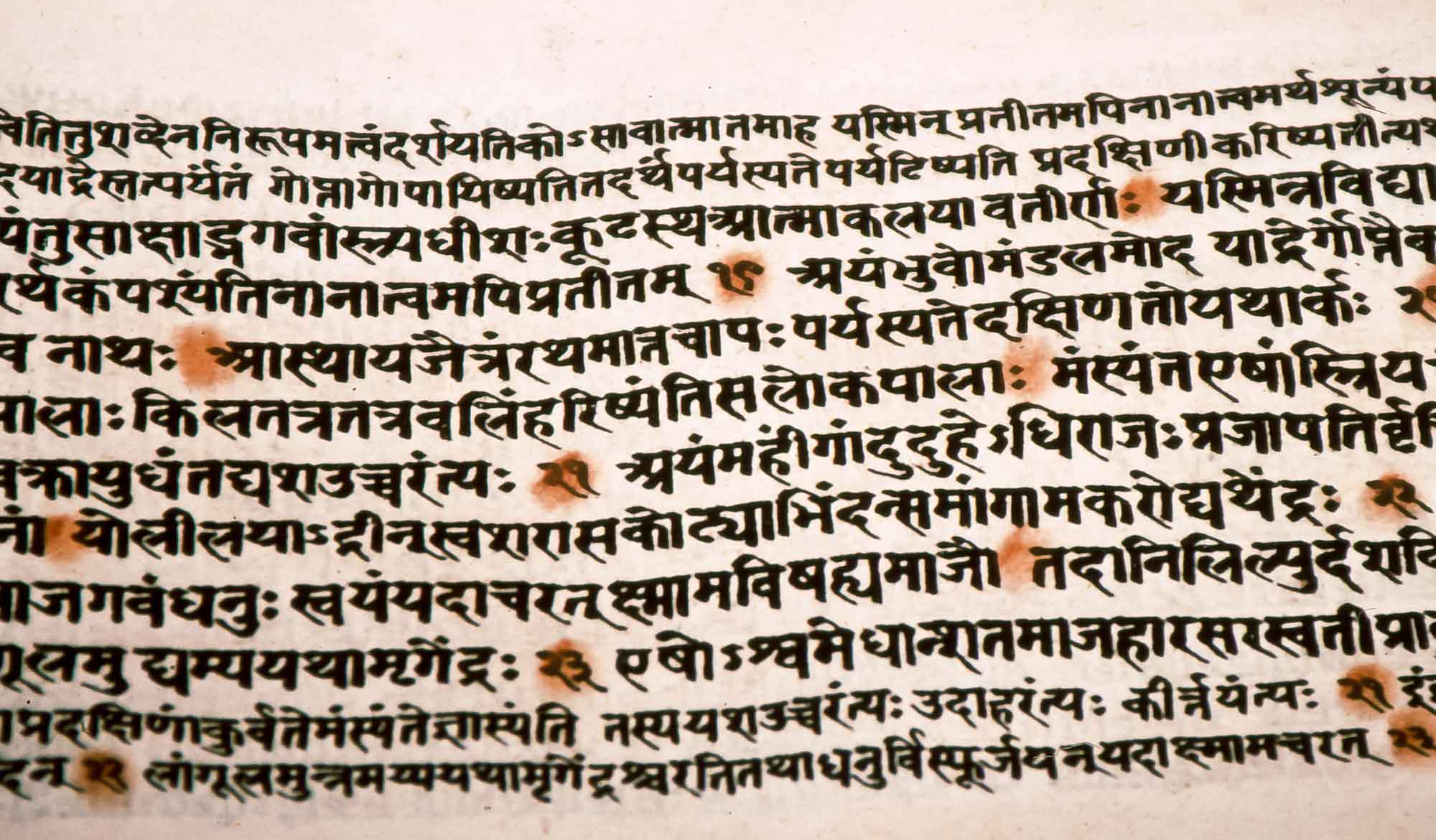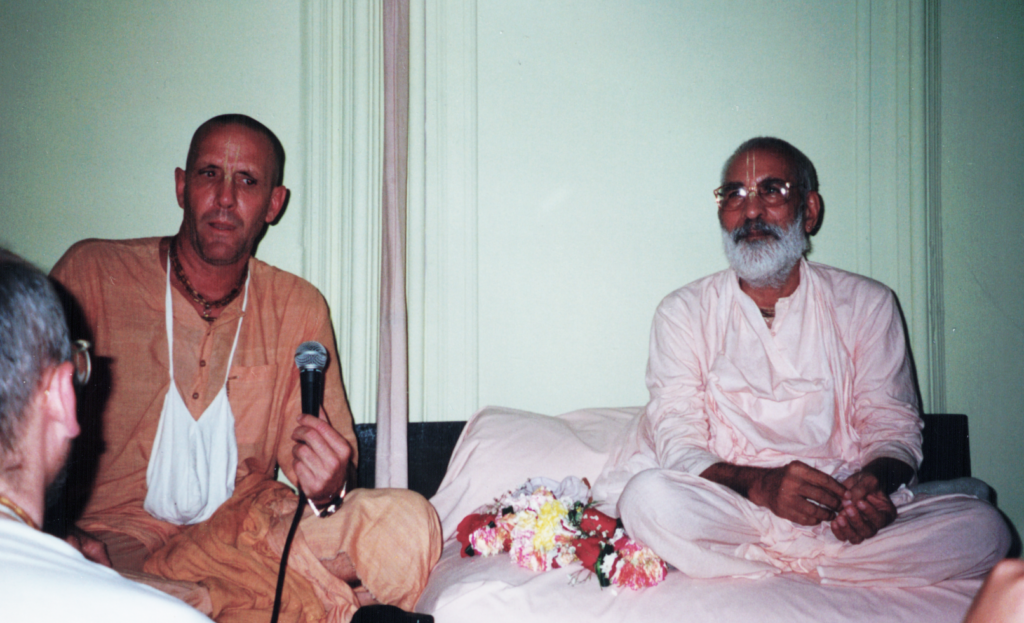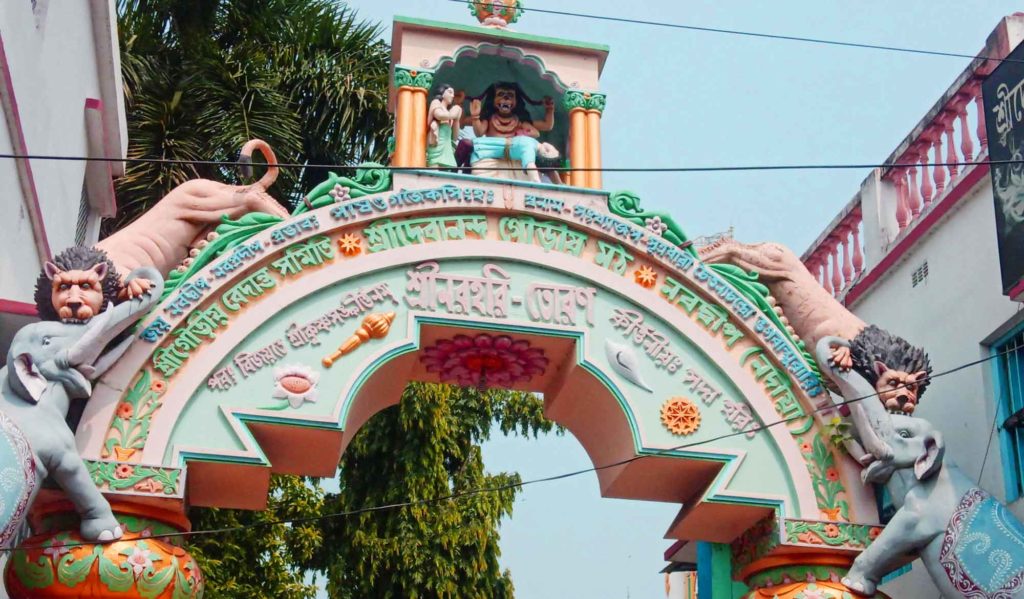Overview
“Have the Vedas Advanced Civilization?” was a short article written by Śrīla Narasiṅgha Mahārāja in 2000 in response to a question by a young Indian student. Śrīla Narasiṅgha Mahārāja responds by defining civilization, and giving examples of how the Vedas have helped mankind.
Question: Have the Vedas advanced civilization? If yes, how?
Answer: Yes. The Vedas always help to advance human civilization, because such literature informs the inquisitive human being about his eternal nature, the Supreme Lord, the material world, the laws of karma, and the process of liberation from all material sufferings.
The Vedas have helped to advance human civilization not just once but many times, starting from the very creation itself. In the beginning of the universe there was only Brahmā, and he began the search for the origin of his existence. Brahmā received mantra from Kṛṣṇa and later he received the Vedic knowledge by revelation. Brahmā in turn taught the Vedic knowledge to his sons like Nārada. Indeed, that was the beginning of civilization.
Sometime later, the mantras of the Vedas were stolen from the mind of Brahmā by two demons named Madhu and Kaitabha. Then Viṣṇu again taught the Veda to Brahmā in the form of what is now known as pañcarātrika literature. In the estimation of Lord Viṣṇu, Who is the maintainer of this universe, there can be no civilization without the guidance of the Vedas. That is not unreasonable.
Civilization, if it is at all to be called such, must be based on complete and proper knowledge, both material and spiritual. This complete knowledge as a whole is called the Veda or Vedas. At the beginning of the age of Kali, some 5000 years ago, the Vedas were written down and have thus become available at present in the form of books. It certainly behoves any intelligent man or woman to take advantage of those books and advance the cause of civilized human life.
There have been many periods in history, particularly here in India, where Kings took very seriously the injunctions of the Vedas and ruled their kingdoms accordingly. Thus civilization in general prospered materially and at the same time many individuals made great spiritual advancement. Vijayanagar, the city never to be forgotten, is one such example. The history of Vijayanagar has been thoroughly documented in numerous textbooks. When the famous world traveller Marco Polo reached Vijayanagar in the 12th century, he was utterly awed by the incredibly high standards of that civilization. Indeed, he commented that a greater civilization did not exist in the world. It should be remembered that Marco Polo, being a Venetian, had seen the greatest civilizations in Europe, and he had also travelled extensively and seen the great civilizations of the world including China. But he held India, whose basis of civilization has always been the Vedas, in the greatest admiration.
Ultimately the human form of life is meant for self-realization, and the Vedas are certainly meant for that aim. However, the Vedas also promote other activities, such as material enjoyment and elevation to the heavenly planets. These activities are recommended in the Vedas for those less intelligent persons who cannot understand the ultimate goal of life. In any case if one follows the injunctions of the Vedas then, step by step one gradually advances and in the end one becomes fully God consciousness.
In the arena of material life, the Vedas have given and continue to give great impetus to human society to become more civilized. From architecture to medicine, from astronomy to political science, from metallurgy to the martial arts, and from music to pharmacology — to name but a few of the most prominent Vedic sciences — the wisdom of the Vedas today continues to amaze and inspire the advancement of civilization in India and abroad.
Hundreds of thousands of educated persons and medical professionals in the West are turning to Ayurveda because of its notable contributions in the effective diagnosis and treatment of chronic disorders for which Western medicine has mere palliatives. Without a doubt, Ayurveda, the mother of all healing, is the fastest growing medical science in the world today.
Equally impressive, but less well known by the Western public, are the Vedic contributions to mathematics. It is no exaggeration to state that there would be no mathematics as we know it today without the fundamental contribution of the Vedas. To wit, not only are the very numbers used internationally of Vedic origin (erroneously called “Arabic”), but Vedic mathematics introduced the concepts of zero, simple and compound numbers, arithmetic progression, the radix 10, fractions, and multiplication by suffix, among others.
We could continue enumerating Vedic advances to human civilization, but do not want to make this answer overly long. However, it is important to note that one of the Veda’s major contributions is a system of social organization, known as varṇāśrama, which is both natural and sophisticated. This system classifies individuals according to natural propensities and stages of life, and gradually leads all persons toward God consciousness, accepting their present situation as the appropriate point of departure.
Vyāsadeva is the compiler of the Vedas and his treatise known as Vedānta-sūtra was considered to be the end of knowledge. However, even after compiling the Vedānta-sūtra Vyāsadeva was not fully satisfied. Then under the instruction of his spiritual master, Nārada Muni, Vyāsadeva achieved the final perfection – he compiled the Śrīmad Bhāgavatam. The Śrīmad Bhāgavatam is therefore considered to be the most beneficial Veda for people in the age of Kali.
kṛṣṇe sva-dhāmopagate dharma-jñānādibhiḥ saha
kalau naṣṭa-dṛśām eṣa purāṇārko ’dhunoditaḥ
“This Bhāgavata Purāṇa is as brilliant as the sun, and it has arisen just after the departure of Lord Kṛṣṇa to His own abode, accompanied by religion, knowledge, etc. Persons who have lost their vision due to the dense darkness of ignorance in the age of Kali shall get light from this Purāṇa.”
In our modern times many sages and great thinkers like Śrī Bhaktisiddhānta Sarasvatī and A.C. Bhaktivedānta Swami Prabhupāda have recommended Śrīmad Bhāgavatam as the single most important literature in the world. Śrīmad Bhāgavatam can certainly help civilization to advance because it gives one direct perception of the self by realization and puts one in immediate contact with the Supreme Personality of Godhead, Lord Śrī Kṛṣṇa.
Our conclusion is that any Eastern or Western civilization that avails itself of the Vedas is sure to make advancement. The only requirement is that people must take the injunctions of the Vedas seriously.
Related Articles
- 📖 When Wise Men Speak Wise Men Listen by Swami B.G. Narasiṅgha Mahārāja (Book)
- Greater Than the Upaniṣads and the Vedas by Śrīla Bhakti Rakṣaka Śrīdhara Deva Gosvāmī
- Religiosity – Real and Apparent by Śrīla A.C. Bhaktivedānta Swami Prabhupāda
- Kṛṣṇa – The Supreme Vedāntist by Śrīla A.C. Bhaktivedānta Swami Prabhupāda
- Rational Vedānta by Śrīla Bhakti Gaurava Narasiṅgha Mahārāja
- Real Religion is not Man-made by Śrīla Bhakti Gaurava Narasiṅgha Mahārāja
- More on ‘Real Religion is Not Man Made’ by Śrīla Bhakti Gaurava Narasiṅgha Mahārāja
- More on Christianity: Only Kṛṣṇa Consciousness Can Enhance Kṛṣṇa Consciousness by Śrīla Bhakti Gaurava Narasiṅgha Mahārāja
- Jesus as a Perfect Christian by Śrīla Bhakti Gaurava Narasiṅgha Mahārāja
- Swastika and Cross by Śrīla Bhakti Gaurava Narasiṅgha Mahārāja
- Star of David or Star of Goloka? by Śrīla Bhakti Gaurava Narasiṅgha Mahārāja
- Does God Exist? by Śrīla Bhakti Gaurava Narasiṅgha Mahārāja
- Tad Viṣṇoḥ Paramaṁ Padaṁ by Śrīla Bhakti Gaurava Narasiṅgha Mahārāja
- Have the Vedas Advanced Civilization? by Śrīla Bhakti Gaurava Narasiṅgha Mahārāja
- The Position of The Bhāgavata Amongst Religious Scriptures by Śrīla Bhakti Gaurava Narasiṅgha Mahārāja
- Avatāras in Every Species by Śrīla Bhakti Gaurava Narasiṅgha Mahārāja
- The History of the Bhagavad-gītā by Swami B.V. Giri
- Jesus in the Vedas by Swami B.V. Giri
- The Great Flood – Are Manu and Noah the Same Person? by Kalki Dāsa
- Zarathustra and The De-evolution of Theism by Kalki Dāsa
Further Reading
- Buddha-Gayā by Śrīla Bhaktivinoda Ṭhākura
- ‘Hindu’ by Śrīla Bhaktivinoda Ṭhākura
- Darśana-Śāstra (Philosophical Treatise) by Śrīla Bhaktivinoda Ṭhākura
- Sukhera Viṣaya (A Matter of Happiness) by Śrīla Bhaktivinoda Ṭhākura
- Śrī-Mūrti-sevā o Pautalikatā (Deity Worship and Idolatry) by Śrīla Bhaktivinoda Ṭhākura
- The Hindu Idols by Śrīla Bhaktivinoda Ṭhākura
- On Durga Siva and Kali in Their Exoteric Aspects: A Criticism on Max Muller by Śrīla Bhaktivinoda Ṭhākura
- Vedānta Darśana (The Vedānta Philosophy) by Śrīla Bhaktivinoda Ṭhākura
- The Bhagavat – It’s Philosophy It’s Ethics and It’s Theology by Śrīla Bhaktivinoda Ṭhākura
Prema Dhāma Deva Stotram with the Narasiṅgha Sevaka Commentary – Verses 61-65
In verses 61 to 65 of 'Prema Dhāma Deva Stotram', Śrīla Śrīdhara Mahārāja narrates the pastime of Śrī Caitanya at Caṭaka Parvata In Purī and explains how the scriptures produced by Brahmā and Śiva are ultimately searching for the personality of Mahāprabhu who is merciful too all jīvas, no matter what their social position.
Prabhupāda Śrīla Sarasvatī Ṭhākura’s Visit to Ayodhyā
With the forthcoming observance of Śrī Rāma Navamī, we present 'Prabhupāda Śrīla Sarasvatī Ṭhākura’s Visit to Ayodhyā' written by Śrīla Bhaktisiddhānta Sarasvatī Ṭhākura Prabhupāda from The Gaudīyā magazine, Vol 3. Issue 21/ In December 1924, after visiting Benares and Prāyāga, Sarasvatī Ṭhākura visited the birth-site of Śrī Rāmācandra in Ayodhyā.
Śaraṇāgati – The Only Path to Auspiciousness
In this article, 'Śaraṇāgati - The Only Path to Auspiciousness', Dhīra Lalitā Dāsī analyses the process of śaraṇāgati (surrender) beginning with śraddhā (faith). She also discusses the role of śāstra and the Vaiṣṇava in connection with surrender.
Ātma Samīkṣā – The Value of Introspection
In this article, "Ātma Samīkṣā – The Value of Introspection" Kalki Dāsa highlights the importance of introspection in the life of a devotee and especially in relation to the worldly environment that surrounds us. He also explains how transcendental sound influences our capacity to introspect.
Prema Dhāma Deva Stotram with the Narasiṅgha Sevaka Commentary – Verses 61-65
In verses 61 to 65 of 'Prema Dhāma Deva Stotram', Śrīla Śrīdhara Mahārāja narrates the pastime of Śrī Caitanya at Caṭaka Parvata In Purī and explains how the scriptures produced by Brahmā and Śiva are ultimately searching for the personality of Mahāprabhu who is merciful too all jīvas, no matter what their social position.
Prabhupāda Śrīla Sarasvatī Ṭhākura’s Visit to Ayodhyā
With the forthcoming observance of Śrī Rāma Navamī, we present 'Prabhupāda Śrīla Sarasvatī Ṭhākura’s Visit to Ayodhyā' written by Śrīla Bhaktisiddhānta Sarasvatī Ṭhākura Prabhupāda from The Gaudīyā magazine, Vol 3. Issue 21/ In December 1924, after visiting Benares and Prāyāga, Sarasvatī Ṭhākura visited the birth-site of Śrī Rāmācandra in Ayodhyā.
Śaraṇāgati – The Only Path to Auspiciousness
In this article, 'Śaraṇāgati - The Only Path to Auspiciousness', Dhīra Lalitā Dāsī analyses the process of śaraṇāgati (surrender) beginning with śraddhā (faith). She also discusses the role of śāstra and the Vaiṣṇava in connection with surrender.
Ātma Samīkṣā – The Value of Introspection
In this article, "Ātma Samīkṣā – The Value of Introspection" Kalki Dāsa highlights the importance of introspection in the life of a devotee and especially in relation to the worldly environment that surrounds us. He also explains how transcendental sound influences our capacity to introspect.








